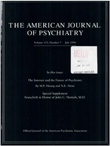Cardiovascular morbidity in high-risk patients during ECT
Abstract
OBJECTIVE: Cardiovascular events are the principal cause of medical morbidity in patients receiving ECT. To assess the risks of ECT for individuals with preexisting cardiovascular disease, the authors examined medical complications in older patients treated with ECT during a 1-year period. METHOD: A case-control design was used in a review of the charts of 80 consecutive patients who received ECT from August 1990 to August 1991. On the basis of accepted clinical criteria, patients over 50 years of age were divided into two groups: one at increased risk for cardiac complications (N = 26) and one at standard cardiac risk (N = 27). Outcome was measured with a scale designed to assess clinically relevant medical complications. RESULTS: The risk group was older and had received more medical consultations before ECT than the nonrisk group. Although patients in the risk group were more likely to develop minor complications during ECT, they did not differ significantly from the comparison group in the rate of major complications. No patients died or sustained permanent cardiac morbidity during ECT. CONCLUSIONS: In contrast to a similar study at the same site 15 years earlier, the current study found ECT to be relatively safe in an unselected study group of elderly patients with preexisting cardiac risk factors. The findings underscore the advances in ECT technique over the past 15 years and the importance of identifying and carefully managing patients with cardiac risk factors before and during ECT.
Access content
To read the fulltext, please use one of the options below to sign in or purchase access.- Personal login
- Institutional Login
- Sign in via OpenAthens
- Register for access
-
Please login/register if you wish to pair your device and check access availability.
Not a subscriber?
PsychiatryOnline subscription options offer access to the DSM-5 library, books, journals, CME, and patient resources. This all-in-one virtual library provides psychiatrists and mental health professionals with key resources for diagnosis, treatment, research, and professional development.
Need more help? PsychiatryOnline Customer Service may be reached by emailing [email protected] or by calling 800-368-5777 (in the U.S.) or 703-907-7322 (outside the U.S.).



